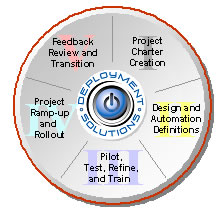 |
|||
 |
|||||

Deployment Methodology |
|
| Standardized Process Methodology. DSI employs a standardized process methodology for planning and performing implementation services. The process methodology consists of standardized procedures and templates that incorporate the technical knowledge and service process expertise of the Company's systems engineers and strictly adheres to other industry standard or accepted process model. Throughout an implementation project, DSI's employees follow documented procedures and utilize standardized templates and tools as the basis for providing customized implementation services tailored for a project's needs and objectives. By utilizing a process methodology that standardizes similar processes across projects and incorporates technological and managerial expertise, DSI has improved the speed, efficiency, quality, and consistency of its implementation services. |  |
|
Phase I – Project Charter Creation. DSI Sales, Operations, and Engineering Groups work closely with the
customer to help define the ultimate goals and objectives of each rollout.
We can help clients develop a Project Charter. Often clients have outlined
much of what they feel is required to correctly position a given project.
Because DSI is solely focused on rapidly deploying technologies for
enterprises, we frequently assist our customers in overlooked challenges
related to implementation and rollout of technology. In addition, we
use this phase of our model to help identify missing data points that
may need to be gathered before project design can begin. Phase II – Design Review and Deployment
Automation. During this phase DSI engineers will thoroughly review the details
of the client’s system design, including hardware components, software
applications, scheduling logistics, and deployment support requirements.
After the review, our engineers will develop procedures for asset tracking,
inventory reporting, configuration, testing, and quality assurance.
In addition, our engineers will adapt our TRaDE tool to automate the
configuration procedures for loading the standard location configuration
onto each system, assembling the system into the proper site-specific
configuration, and testing the functionality of each peripheral. We will assign a Project Manager (PM) who will develop an acceptable
schedule, a training plan for our staff, and a Deployment Manual. In
addition, the PM will ensure that all relevant engineering design is
captured, approved, and disseminated. Phase III – Pilot Test, Refine, and Train.
The PM will arrange training for DSI technicians who will execute the
processes developed in Phase II. The DSI engineers who developed the
processes will provide consultation and assistance as needed. In addition,
we will rely on the customer’s expertise to assure we completely
understand their processes and desired results. All processes and documentation
will be refined, as necessary, based on the ‘real-life’ experiences
gained in each installation. Phase IV – Project Ramp-up and Rollout.
The tested, developed, and approved processes will then be ready for
production. The receipt of equipment in the Configuration center, inventory
tracking, configuration and staging, project management, and shipment
of the technology will be accomplished in accordance with the required
schedule. Phase V – Feedback, Review, and Transition.
During the course of the project, as sites are completed, DSI will
survey our progress with the client. Their feedback will be used to
continuously refine the process. Shortly after the start of the rollout,
and again at the completion of the project, a DSI executive will seek
similar feedback and review of the project from key contacts to ensure
all expectation are being met. In addition, DSI provides the designed
transition of identified key data to the client’s support team. |
|